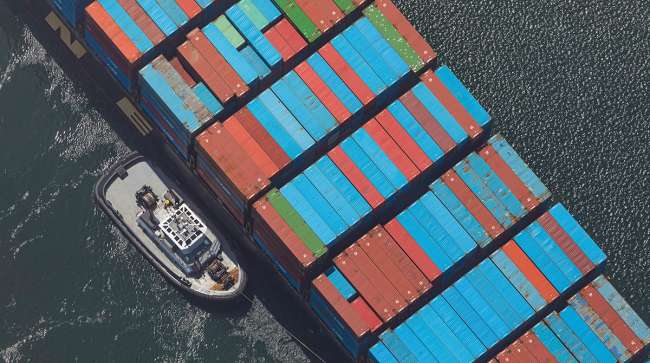A tugboat assists a containership at the Port of Long Beach. (Tim Rue/Bloomberg)
Container liners are starting to sever shipping routes that link the U.S. and China across the Pacific, as President Donald Trump’s trade war upends the industry and forces the two largest economies apart.
Among signs of disruption are plunging fees, fewer services and a pall of uncertainty over what for decades has been one the main maritime highways of the global economy, carrying manufactured goods and vital commodities.
German container shipping group Hapag-Lloyd AG has canceled 30% of China-to-U.S.-bound shipments, according to a spokesperson. Separately, Swiss liner Kuehne + Nagel International AG said some trades had stopped completely, while it expected a 25% to 30% drop in bookings from China to the U.S., CEO Stefan Paul told investors on a conference call.
Kuehne + Nagel ranks No. 10 and Hapag-Lloyd ranks No. 18 on the Transport Topics list of the top 50 largest global freight companies.

The Trump administration’s globe-spanning trade war that has dominated the president’s opening months in office has trained its harshest measures against China, with the imposition of U.S. import levies totaling 145%, and similar punitive retaliatory measures from Beijing. While there have been carve-outs for some goods, the dispute has roiled the shipping industry.
Although Trump and other senior officials have talked up the chances of a potential deal with China — and negotiations will take place in Switzerland later this week — any resolution of the dispute may take months to hammer out. In the meantime, executives in China are turning away from the U.S. market.
As a result, fees are plunging. The cost of shipping a 40-foot box from Shanghai to Los Angeles — port nodes on either side of the Pacific — hit the lowest since 2023 in late March, according to the data from Drewry Shipping Consultants, a maritime advisory firm. A tally of rates across global routes has also softened.
“It’s a trade lane on what is a global highway,” said Joe Kramek, CEO at the World Shipping Council, whose members operate 90% of global liner capacity. “So it does have ripple effects all the way across.”
Seth Clevenger and Mike Senatore dive into the Transport Topics Top 100 list of the largest logistics companies. They address trade challenges, mergers, sector trends and more. Tune in above or by going to RoadSigns.ttnews.com.
Shippers are also contending with U.S. measures beyond the barrage of levies, adding a further layer of complications. These include the ending of a tax exemption for small shipments, as well as a potentially disruptive plan to charge hefty fees on large Chinese ships calling at American ports.
“There’s uncertainty about what will happen to cargo flows in and out of the U.S.,” said Niels Rasmussen, chief shipping analyst at trade group Bimco. In contrast, there’s no policy uncertainty in trades elsewhere, so shipowners can approach these normally, he said.
Elsewhere in the shipping market, there are mounting headaches for the dry bulk operators that haul farm products, as well as tanker owners, whose fleets had been used to ferry U.S. energy exports to Asia’s largest economy.
Flows of crude from the U.S. Gulf to China came to a stop in April, after reaching a year-to-date peak of nearly 174,000 barrels a day in March, Kpler data shows. Among individual vessels, a tanker hauling U.S. propane diverted from China mid-voyage after Beijing slapped punitive taxes on American imports.
The rerouting of U.S. coal and soybean cargoes away from China to nearer markets is expected to reduce sailing distances, and therefore hurt so-called ton-mile demand for the dry-bulk sector, according to Roar Adland, the global head of research at shipbroker SSY.
“Current levels of U.S. tariffs, and Chinese countertariffs, have effectively shut down most bilateral dry bulk commodity trade,” said Adland.







